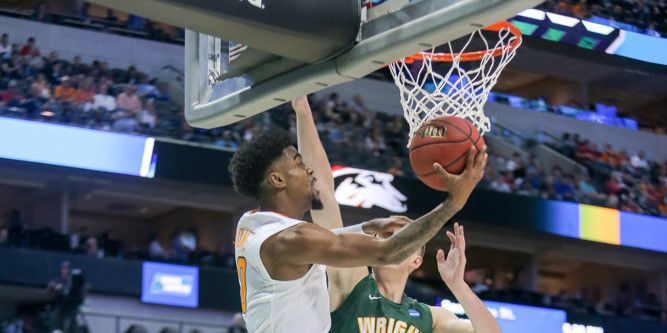One of the greatest indicators of health for last year’s basketball team was the absence of any real blueprint for success. From our post on the eve of the NCAA Tournament:
- The Vols are 19-3 when shooting at least 33.3% from three. But they also beat Florida, Texas A&M, and won at Rupp Arena shooting less than that.
- The Vols are 17-0 when holding their opponent under 40% from the floor. But they also beat Kentucky twice when the Cats shot above that.
- The Vols are 14-0 when assisting on at least 64% of their made shots. But they beat Purdue and Kentucky when assisting on less than half of their makes.
- Grant Williams has scored 20+ eight times, but the Vols lost two of those games. Meanwhile one of their best performances of the year was at Mississippi State, when he had eight.
- Admiral Schofield has scored 20+ seven times, but only two of those came against tournament teams (Kentucky twice). Meanwhile the Vols beat nine-seed NC State in the Bahamas when Schofield had zero.
- The Vols are 13-2 when Jordan Bowden scores double digits, but just annihilated Arkansas in the SEC Tournament when he had two points.
(All these stats come from the fine folks at Sports Reference)
After two years of needing big numbers from Kevin Punter or Robert Hubbs in seasons that went south when their health did, the 2018 Vols were far more than one-dimensional. They beat big-name opponents in multiple ways, and finished in the Top 50 nationally in a variety of stats: three-point shooting percentage, free throw shooting percentage, offensive rebounding, assist percentage, blocked shot percentage, field goal percentage defense, and three-point percentage defense.
The Vols are well-rounded and get almost everyone back. They’re defending SEC Champions with the highest preseason ranking in program history. Things look really good.
How can the Vols be even better?
Two-Point Field Goal Percentage
Last year only two tournament teams – not at-large teams, but the entire field of 68 – had a worse shooting percentage inside the arc than Tennessee: 16-seed Radford (shout out to my southwest Virginia neighbors), and 11-seed Syracuse who played in the First Four. The Vols made 47.3% of their shots from two, 278th nationally.
Kyle Alexander is tremendous at this, ranking 18th nationally on shooting percentage inside the arc at 67.9%. The rest of the Vols? Not so much.
The short version: the Vols don’t have a bunch of guys who finish well at the rim, or guards who create their own shot. The latter is probably by design in part: as you can see above, Tennessee excels at offensive rebounding, getting to the free throw line, and knocking them down. And the Vols’ exceptional ball movement – remember, Tennessee led the nation in assist percentage for much of the year and finished seventh – created plenty of open looks from three. It was an offense that finished 36th nationally in KenPom. It’s certainly not broken. But to get to a championship level, Tennessee needs to be more efficient from two.
Jordan Bowden was a better shooter from three (39.5%) than two (39.2%). Jordan Bone and Lamonte Turner were only slightly better. On the other end of the spectrum, one player to watch here is Derrick Walker. He’s the only player on the roster (with freshman DJ Burns looking at a possible redshirt) with the size and strength to get away with it, but he made 59.6% of his attempts from two. Will Tennessee run more of its offense through big men down low to get higher percentage looks? This is the other side of the coin of something else the Vols could do better:
Shoot More Threes…?
We looked at this at the end of the season back in March. The Vols shot 38% from three, 45th nationally. But only 35.7% of Tennessee’s shot attempts were threes, 220th nationally. If 65ish% of your attempts are twos, and you’re not a great two-point shooting team…should the Vols just jack it up more?
Tennessee’s three-point shooting last year was bolstered by so many players knocking them down. Bowden, Turner, Bone, and Schofield were all 38-40% shooters from three. The Vols do lose James Daniel, who hit 37.2%.
We know Tennessee can create good looks inside-out thanks to Williams and Schofield. Should the Vols take more of those looks? Or will the greatest room for improvement come from Alexander and Walker growing their scoring footprint in the paint, thus improving Tennessee’s percentage inside the arc?
Foul Less
Tennessee was 36th nationally in fouls last year, despite playing the 282nd fastest pace in college basketball. Some of this is the nature of the beast when you have undersized bigs and are aggressive defensively. And the Vols didn’t necessarily lose because of this alone, as teams shot 71% at the line against UT, an average 151st nationally.
But Grant Williams averaged 3.3 fouls per game, and fouled out six times. It was most costly in the loss at Arkansas, but the Vols also fell to Villanova, Missouri, and at Georgia when Williams was disqualified. They did beat Georgia Tech, and famously won the SEC by beating Georgia in the rematch after he fouled out. And when you run the numbers per minute, the Vols had lots of foul-happy reserves, led by Derrick Walker and Yves Pons. This isn’t just one player’s issue.
There’s clearly no need for a team that finished sixth in KenPom defensive efficiency to change its identity. But even fouling a little less, with guys like Williams playing fewer minutes with four fouls, can make a difference this season.

